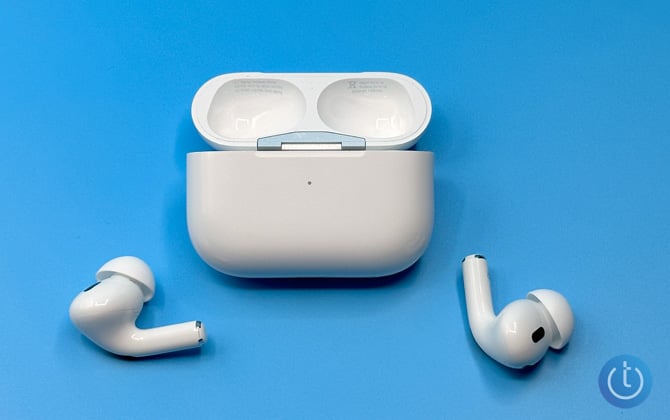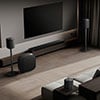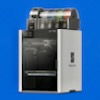We may earn commissions when you buy from links on our site. Why you can trust us.
AirPods Pro 2 as Hearing Aids Review: Revolutionary, but Flawed
Apple has just proven what I’ve asserted for years: there is no reason why hearing aids, OTC or prescription, have to cost $1,000 or more. For just $250, AirPods Pro 2 now perform as self-fitting hearing aids that provide crystal clear amplified sound for both ambient sound as well as Bluetooth music listening and phone calls.
I’ve been testing OTC hearing aids since they first launched in 2022 and spent a couple of weeks reviewing the AirPods Pro 2 hearing aid capabilities. While they ably perform as OTC hearing aids, I found they are very much a v1.0 product, with the usual first-generation compromises, omissions, and flaws to contend with.

| + Pros | – Cons |
|
|
As with all closed Bluetooth OTC hearing aid buds such as the HP Hearing Pro ($499), the Eargo Link ($799), and the new $99.99 JLab Hear, the AirPods Pro 2 make your own voice sound a bit disembodied. They also “only” provide around five to ten hours of battery life, which is great for standard music Bluetooth buds but hardly the “all-day” battery life provided by pricier hearing aids without Bluetooth. For instance, my current OTC hearing aid favorites, the Sony CRE-C20 OTC hearing aids, operate for a whopping 28 hours on a single charge, but they cost $999.99 and don’t include Bluetooth for music or phone calls.
Read more: Review: Sony's New CRE-C20 Are the Best OTC Hearing Aids I've Tested
If nothing else, Apple has provided a way for you to easily test if you’re suffering mild or moderate hearing loss. Do you find yourself saying, “What’d you say?” to friends? Are you turning up the TV volume louder than usual or are you relying more on closed captioning? iOS 18.1 can tell you for free – no pricey audiologist visit necessary – if you’re experiencing some hearing loss, and with your AirPods Pro 2, you have a cheap, introductory solution.
Set Up
Apple makes it simple to pair your AirPods Pro 2 with your iPhone and configure them as hearing aids. The earbuds come out of the box in pairing mode and appear on your iPhone when you open the case. A single tap is all it takes to complete the process.
Once your AirPods Pro 2 are paired, you can set them up as hearing aids through the Settings app. Go to Settings > AirPods Pro 2 > Take a Hearing Test. When you’re finished with the test, you select “Set Up Hearing Aid,” then toggle on “Media Assist,” “Adjust Music and Video,” and “Adjust Calls and FaceTime.”
While this basic setup routine makes a huge difference, I recommend fine-tuning the settings to better meet your needs. Within your AirPods Pro 2 Settings, you’ll be able to adjust things like the amplification volume and the balance between ambient noise and voices and turn on “Conversation Awareness.”
Unfortunately, navigating these more advanced settings is not an intuitive process. In fact, it's complicated enough that I decided to cover it in a separate article on How to Set up Your AirPods Pro 2 as Hearing Aids the Right Way.
Performance
First, on the positive side, AirPods Pro 2, considering they were not designed from the ground up as hearing aids, do an excellent job of increasing and crystalizing sound, especially voices. Plus, you can easily reduce unwanted, non-vocal environmental noises such as running water, light switches, creaky floors, keyboard clacking, air conditioning/heating, etc.
AirPods Pro 2 also continue to operate as hearing aids when disconnected from your iPhone. When you wander further than 30 feet from your phone, you will hear an initial beeping signifying you’re disconnected.
Design
AirPods’ most obvious “flaw” is aesthetic: they’re visible, something the hearing-impaired like to assiduously avoid advertising. But AirPods’ obviousness is actually an advantage over “normal” hearing aids. Tens of millions of people already wear AirPods – they’re, by far, the most popular earbuds extant. You’ll fit in perfectly with the vast AirPods-wearing masses, with no one the wiser about your aural deficiencies. When you continue to wear your AirPods during a conversation, your co-conversationalists will not suspect you’re hard of hearing, just rude. Now, your awkward choice is to admit failing hearing or failing manners.
AirPods Pro 2’s six hearing aid flaws
Battery life is not “all-day”
Most standard hearing aids offer “all-day” battery life, usually 12-16 hours. The new non-Bluetooth Sony CRE-C20 OTC hearing aids offer a whopping 28 hours of single-charge battery life. AirPods Pro 2, with mixed music playback with noise canceling and hearing aid use, provide around five-to-six hours of single-charge battery life.
However, this battery limitation is not necessarily a deal breaker. Folks like me with mild or moderate hearing loss don’t necessarily want to wear a hearing aid all day, only when we think we need to, such as when watching TV or when in a conversation situation. For intermittent use, where the buds are returned to their charger to fully power up when not in use, six hours-plus battery life is only an occasional minor annoyance.
Your own voice sounds weird
As noted, closed Bluetooth buds that seal your ear canal make your own amplified hearing aid voice sound disembodied. AirPods’ excellent transparency mode, combined with its equally excellent amplification, reduces the disembodied nature of your voice better than other closed bud-style OTC hearing aids I’ve used – but your voice still doesn’t sound anywhere near as natural as when wearing normal, open hearing aids. Hearing your own amplified disembodied voice seemingly come out of thin air in front of you take a bit of getting used to. Closed-bud hearing aids also tend to magnify food and gum chewing noises, although the AirPods are also less so than other models I’ve tested.
Quality declines when multiple people speak simultaneously
For some reason, in situations where multiple people are talking simultaneously, such as parties, group lunches, or meetings, the AirPods transparency mode gets muddy and warbly. Even when voices were moderately raised – me speaking loud enough to make myself heard or talking with my wife with the TV sound on – the sound seemed to dampen or warble. I found and even turned off – after some lengthy Settings drilling – the AirPods’ “Loud Sound Reduction,” but this didn’t seem to help.
Amplification drops when you turn slightly away from the source
I found the AirPods amplified most effectively when facing the sound I wanted to hear. Turning my head away from the sound source slightly lowered amplification, which impacts clearly hearing single individuals when surrounded by a group of people chatting – assuming the AirPods amplification doesn’t dampen or warble with sound overload.
There’s a weird “air” sound when outdoors
When I stick the AirPods Pro 2 in my ears outside, it’s as if I can hear the air itself – not the wind, mind you, but I hear what sounds like…air. I had to turn down the amplification volume to minimize or eliminate this air sound and still get an amplification of the sounds I wanted to hear.
There are no instructions
Apple provides no in-app/settings guidance on where to find or adjust varying hearing aid settings. It took me a couple of days to discover all the settings and features that I’ve explained here, and I’m not entirely sure I haven’t missed anything. And this is coming from someone who has tested OTC hearing aids for years. Those new to OTC hearing aids may find themselves even more lost in the weeds.
The bottom line
iOS 18.1 is Apple’s first attempt at transforming AirPods into hearing aids. Considering AirPods Pro 2 weren’t designed as hearing aids first, and despite their flaws, it’s a remarkable achievement. Apple’s engineers will likely learn from the experience and input and, hopefully, improve both performance and operations via additional iOS updates.
Overall, AirPods Pro 2 ($250, usually $189) as hearing aids are best for situational indoor use where the conversation is minimal – watching TV, concerts, business seminars, and presentations, no more than three people in conversation groups, in mass transit situations to hear announcements. With just six hours of battery life, don’t plan on wearing them all day, or, with its overload dampening issue, to help clarify conversations outdoors, at noisy parties, or in crowded restaurants.
Even with my caveats, I’d recommend all iPhone/AirPods Pro 2 owners upgrade to iOS 18.1 and take the hearing test just to assess their hearing health. Then, apply your personal hearing profile results to your AirPods Pro 2 to give you a sense of how hearing aids can improve your hearing and your life, whether you opt to use the AirPods as your primary hearing aids or decide to buy “real” ones.
Final thoughts
Looking to the future, I have six suggestions for Apple on how to make the AirPods better hearing aids.
- Create a separate “Hearing Aid” app or Settings section specifically for controlling AirPods’ hearing aid functions, including a set-up and usage guide.
- Create environmental pre-sets to allow AirPods to better adapt and operate in either single or multi-voice situations.
- Create directionality adjustments, available on many hearing aids, so we can choose to hear sounds either in front or all around.
- Fix the amplification dampening in multi-simultaneous voice conversation situations.
- Create “open” AirPods Pro ear tips specifically for hearing aid use as an accessory. These would be perforated ear tips that allow ambient sound to enter and mix with amplified sound, the way standard hearing aids create “natural” open sound. “Open” ear tips would make your own voice sound more natural and may lessen the dampening I experienced when confronted with multiple simultaneous voices. Even with “open” ear tips, Apple’s excellent noise canceling should still create a more-or-less closed environment for private Bluetooth music listening.
- Create AirPod Pro 2s in different skin tones so they can more naturally “disappear” and reduce the need to explain while you’re still wearing them during conversation.
With millions of AirPods Pro 2 already sticking out of customers' ears, Apple can essentially force the rest of the OTC hearing aid industry to figure out a new hardware pricing model to compete. And Apple will further pressure OTC hearing aid makers to lower their prices when it inevitably introduces new or less expensive AirPods that also can be turned into hearing aids. I can’t wait to see what comes next.
[Image credit: Stewart Wolpin/Techlicious]
Stewart Wolpin has been writing about consumer electronics for more than 35 years, including news, reviews, analysis and history, and has attended and covered nearly 50 Consumer Electronic Shows and around a dozen IFA shows in Berlin. For the Consumer Technology Association (CTA), he is an elector for and writes the official biographies of the annual CT Hall of Fame inductees, and is the keeper of the industry’s official history.

















